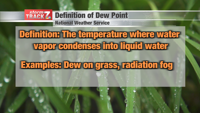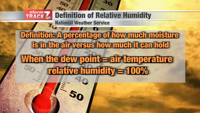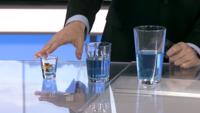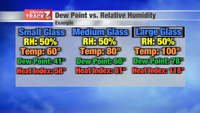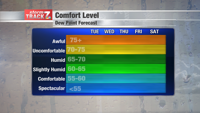Weather Wonders: Dew Point vs Relative Humidity | Schnack Weather Blog

Dew point and relative humidity, two terms that have floated around many weather forecasts over the years. What exactly do they mean and when are they best used to describe outdoor conditions? Let’s break this down for you and in terms of explaining humidity, one metric is much better than the other.
There are longer and more complicated definitions to describe dew point. The best way to put it is that it is the temperature at which water vapor condenses into liquid water. You see examples of this in the morning when there is dew on the grass or when radiation fog occurs.

The description of relative humidity also takes many different forms. One way to define the term is that relative humidity is a percentage of the amount of moisture in the air compared to the amount it can hold.
Dew point and relative humidity are related to each other. When the dew point and the air temperature are the same, the relative humidity is 100%.
With these definitions it is sometimes difficult to understand exactly what they mean, so let’s do a visual demonstration.

Above is a demonstration of the atmosphere with three different temperatures. The left has an air temperature of 60 degrees Fahrenheit, the middle one 80 degrees Fahrenheit, and the right one 100 degrees Fahrenheit. The key here is that the warmer the air, the more moisture it can hold.

Now, by putting some numbers on these glasses, you can see that even though the relative humidity is 50% in each situation, what it feels like outside varies greatly. The large glass with a temperature of 100 degrees and a relative humidity of 50% corresponds to a dew point of 78 degrees. It is much more humid than the small reservoir where the dew point is only 41.
This is why it is important to understand the difference between relative humidity and dew point. Relative is a key word in this case because it corresponds to a variation in air temperature. Dew point is a more consistent way of determining humidity. A higher dew point means a higher temperature is needed to condense water. That’s going to mean more humidity in the atmosphere, creating those sticky conditions.

For our dew points we have a range of values to show what each dew point means for how it feels outside. A dew point below 55 is spectacular comfort. 55-60 is comfortable, 60-65 is slightly damp, 65-70 is damp, 70-75 is uncomfortable, and 75+ is in that dreadful range. These aren’t exact terms for these ranges, but it’s a good guide to determining your comfort level when you’re out and about.

